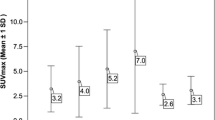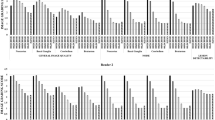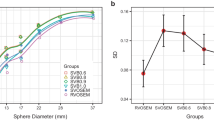Abstract
Objective
This work assessed the usefulness of fully three-dimensional ordered subset expectation maximization (3D-OSEM) algorithm for lymph node (LN) metastases from lung cancer. 3D-OSEM images were evaluated by comparing them with those reconstructed by conventional algorithms, such as conventional OSEM algorithm (2D-OSEM) for 2D acquisition and Fourier rebinning plus conventional OSEM algorithm (FORE + OSEM) for 3D acquisition.
Materials and methods
In a phantom study, the contrast ratio, the image noise and the signal-to-noise ratio (SNR) were calculated, and the detectability and the image quality of these images were visually evaluated. In a clinical study, 14 patients suffering from lung cancer with LN metastases were evaluated. The image quality and the malignancy, and the detectability were visually evaluated.
Results
The contrast ratio was significantly improved using 3D-OSEM as compared with FORE + OSEM, and it was similar to 2D-OSEM. The image noise and SNR in 3D-OSEM images were significantly improved compared with those by other algorithms (p < 0.001). In the visual assessment, the image quality was significantly improved in 3D-OSEM images compared with those by 2D-OSEM and FORE + OSEM (p < 0.001, p = 0.001, respectively). In the clinical study, the image quality and the detectability of LN metastases were improved in 3D-OSEM images compared with those by FORE + OSEM (p < 0.001, p = 0.006, respectively), and image quality and detectability were similar to those of 2D-OSEM images.
Conclusions
3D-OSEM algorithm successfully improved the diagnostic accuracy of LN metastases in 3D-PET tests.





Similar content being viewed by others
References
American Cancer Society: Cancer facts and figures (accessed 14 September 2010). http://www.cancer.org/acs/groups/content/@nho/documents/document/acspc-024113.pdf.
Sakao Y, Miyamoto H, Yamazaki A, Oh T, Fukai R, Shiomi K, et al. Prognostic significance of metastasis to the highest mediastinal lymph node in nonsmall cell lung cancer. Ann Thorac Surg. 2006;81:292–7.
Kubota K, Matsuzawa T, Fujiwara T, Ito M, Hatazawa J, Ishiwata K, et al. Differential diagnosis of lung tumor with positron emission tomography: a prospective study. J Nucl Med. 1990;31:1927–32.
Weber WA, Figlin R. Monitoring cancer treatment with PET/CT: does it make a difference? J Nucl Med. 2007;48(Suppl 1):36S–44S.
Beyer T, Townsend DW, Brun T, Kinahan PE, Charron M, Roddy R, et al. A combined PET/CT scanner for clinical oncology. J Nucl Med. 2000;41:1369–79.
Patrick V, Stefan R, Hilmar K, Hrvoje S, Stefan M, Andreas B, et al. Lymph node staging with dual-modality PET/CT: enhancing the diagnostic accuracy in oncology. Eur Radiol. 2006;58:383–9.
Visvikis D, Griffiths D, Costa DC, Bomanji J, Ell PJ. Clinical evaluation of 2D versus 3D whole-body PET image quality using a dedicated BGO PET scanner. Eur J Nucl Med Mol Imaging. 2005;32:1050–6.
Mawlawi O, Podoloff DA, Kohlmyer S, Williams JJ, Stearns CW, Culp RF, et al. Performance characteristics of a newly developed PET/CT scanner using NEMA standards in 2D and 3D modes. J Nucl Med. 2004;45:1734–42.
Hudson HM, Larkin RS. Accelerated image reconstruction using ordered subsets of projection data. IEEE Trans Med Imag. 1994;13:601–9.
Defrise M, Kinahan PE, Townsend DW, Michel C, Sibomana M, Newport DF, et al. Exact and approximate rebinning algorithms for 3-D PET data. IEEE Trans Med Imag. 1997;16:145–58.
Chiang S, Cardi C, Matej S, Zhuang H, Newberg A, Alavi A, et al. Clinical validation of fully 3-D versus 2.5-D RAMLA reconstruction on the Philips-ADAC CPET PET scanner. Nucl Med Commun. 2004;25:1103–7.
Lange K, Carson R. EM reconstruction algorithms for emission and transmission tomography. J Comput Assist Tomogr. 1984;8:306–16.
Iatrou M, Ross SG, Manjeshwar RM, Stearns CW. A fully 3D iterative image reconstruction algorithm incorporating data corrections. Nuclear Science Symposium Conference Record 2004 IEEE;4:2493–7.
Strobel K, Rüdy M, Treyer V, Veit-Haibach P, Burger C, Hany TF. Objective and subjective comparison of standard 2-D and fully 3-D reconstructed data on a PET/CT system. Nucl Med Commun. 2007;28:555–9.
National Electrical Manufacturers Association. NEMA Standards Publication NU 2-2007. Performance Measurements of Positron Emission Tomographs. Rossly, VA;2007.
Penney BC, King MA, Schwinger RB, Baker SP, Stritzke P, Doherty PW. Constrained least-squares restoration of nuclear medicine images: selecting the coarseness function. Med Phys. 1987;14:849–58.
Burger C, Goerres G, Schoenes S, Buck A, Lonn AH, Von Schulthess GK. PET attenuation coefficients from CT image: experimental evaluation of the transformation of CT into PET 511-keV attenuation coefficients. Eur J Nucl Med Mol Imaging. 2002;29:922–7.
Bergstom M, Eriksson L, Bohm C, Blomgvist G, Litton J. Correction for scattered radiation in a ring detector positron camera by integral transformation of the projections. J Comput Assist Tomogr. 1983;7:42–50.
Ollinger JM. Model-based scatter correction for fully 3D PET. Phy Med Biol. 1996;41:153–76.
Inoue K, Sato T, Kitamura H, Ito M, Tsunoda Y, Hirayama A, et al. Improvement of the diagnostic accuracy of lymph node metastases of colorectal cancer in 18F-FDG-PET/CT by optimizing the iteration number for the image reconstruction. Ann Nucl Med. 2008;22:465–73.
Nagayoshi M, Murase K, Fujino K, Uenishi Y, Kawamata M, Nakamura Y, et al. Usefulness of noise adaptive non-linear gaussian filter in FDG-PET study. Ann Nucl Med. 2005;19:469–77.
Paul AK, Tatsumi M, Yutani K, Fujino K, Hashikawa K, Nishimura T. Effects of iterative reconstruction on image contrast and lesion detection in gamma camera coincidence imaging in lung and breast cancers. Nucl Med Commun. 2002;23:103–10.
Lartizien C, Kinahan PE, Comtat C. A lesion detection observer study comparing 2-dimensional versus fully 3-dimensional whole-body PET imaging protocols. J Nucl Med. 2004;45:714–23.
R Development Core Team. R: A language and environment for statistical computing. R Foundation for Statistical Computing, Vienna, Austria. 2008 (accessed 14 September 2010). ISBN 3-900051-07-0. http://www.R-project.org.
Naruke T, Tsuchiya R, Kondo H, Nakayama H, Asamura H. Lymph node sampling in lung cancer: how should it be done? Eur J Cardiothorac Surg. 1999;16:S17–24.
Vogel WV, Wensing BM, van Dalen JA, Krabbe PF, van den Hoogen FJ, Oyen WJ. Optimised PET reconstruction of the head and neck area: improved diagnostic accuracy. Eur J Nucl Med Mol Imaging. 2005;32:1276–82.
Kundel HL, Polansky M. Measurement of observer agreement. Radiology. 2003;228:303–8.
van der Putten L, Hoekstra OS, de Bree R, Kuik DJ, Comans EF, Langendijk JA, et al. 2-Deoxy-2[F-18]FDG-PET for detection of recurrent laryngeal carcinoma after radiotherapy: interobserver variability in reporting. Mol Imag Biol. 2008;10:294–303.
Lartizien C, Comtat C, Kinahan PE, Ferreira N, Bendriem B, Trébossen R. Optimization of injected dose based on noise equivalent count rates for 2- and 3-dimensional whole-body PET. J Nucl Med. 2002;43:1268–78.
Inoue K, Sato T, Kitamura H, Hirayama A, Kurosawa H, Tanaka T, et al. An anthropomorphic pelvis phantom for optimization of the diagnosis of lymph node metastases in the pelvis. Ann Nucl Med. 2009;23:245–55.
Kubota K, Itoh M, Ozaki K, Ono S, Tashiro M, Yamaguchi K, et al. Advantage of delayed whole-body FDG-PET imaging for tumour detection. Eur J Nucl Med. 2001;28:696–703.
Acknowledgments
We thank Elisabeth Berg, B.Sc. and Chikako Suzuki, M.D., Karolinska Institute for their advice on statistical analysis. And, we sincerely appreciate thoracic oncologists and surgeons in National Cancer Center Hospital East for their cooperation for this study. This work was supported by the Foundation for the Promotion of Cancer Research for the Third Term Comprehensive 10-year Strategy for Cancer Control. This work was partially supported by the Health and Labor Sciences Research Grants for Third Term Comprehensive 10-year Strategy for Cancer Control, the Grants-in-Aid for Cancer Research (17–12) from the Ministry of Health, Labor and Welfare, and the Grants-in-Aid for Scientific Research (C) (No. 19591743) from Japan Society for the Promotion of Science. Dr. Hirofumi Fujii is research member of JST-BIRD.
Author information
Authors and Affiliations
Corresponding author
Rights and permissions
About this article
Cite this article
Inoue, K., Moriya, E., Suzuki, T. et al. The usefulness of fully three-dimensional OSEM algorithm on lymph node metastases from lung cancer with 18F-FDG PET/CT. Ann Nucl Med 25, 277–287 (2011). https://doi.org/10.1007/s12149-010-0462-y
Received:
Accepted:
Published:
Issue Date:
DOI: https://doi.org/10.1007/s12149-010-0462-y




